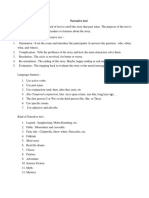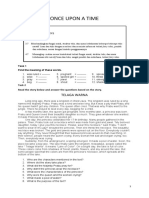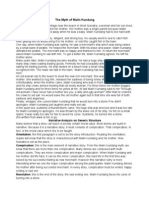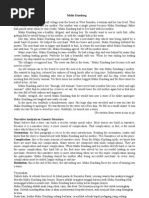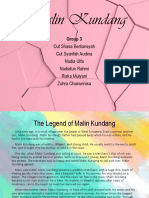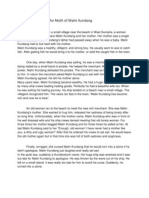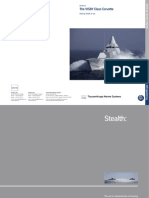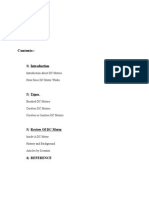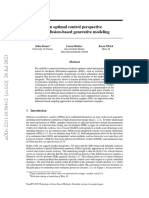0 ratings0% found this document useful (0 votes)
36 viewsEnglish For Entertainments 1.folktales 2. Fable 3. Biography 4. Spoof
English For Entertainments 1.folktales 2. Fable 3. Biography 4. Spoof
Uploaded by
RuswantoThis document provides an overview of Module 3 of an English for Entertainments course. It discusses different types of entertainments like folktales, fables, biographies, and spoofs. It then provides details on the typical structure of folktales, including orientation, complication, and resolution. It also lists common elements of folktales like setting, characters, plot, problem, and solution. Finally, it shares a full folktale from Indonesia called "The Legend of Malin Kundang" as an example.
Copyright:
© All Rights Reserved
Available Formats
Download as PPTX, PDF, TXT or read online from Scribd
English For Entertainments 1.folktales 2. Fable 3. Biography 4. Spoof
English For Entertainments 1.folktales 2. Fable 3. Biography 4. Spoof
Uploaded by
Ruswanto0 ratings0% found this document useful (0 votes)
36 views11 pagesThis document provides an overview of Module 3 of an English for Entertainments course. It discusses different types of entertainments like folktales, fables, biographies, and spoofs. It then provides details on the typical structure of folktales, including orientation, complication, and resolution. It also lists common elements of folktales like setting, characters, plot, problem, and solution. Finally, it shares a full folktale from Indonesia called "The Legend of Malin Kundang" as an example.
Original Description:
kf
Original Title
Folktale
Copyright
© © All Rights Reserved
Available Formats
PPTX, PDF, TXT or read online from Scribd
Share this document
Did you find this document useful?
Is this content inappropriate?
This document provides an overview of Module 3 of an English for Entertainments course. It discusses different types of entertainments like folktales, fables, biographies, and spoofs. It then provides details on the typical structure of folktales, including orientation, complication, and resolution. It also lists common elements of folktales like setting, characters, plot, problem, and solution. Finally, it shares a full folktale from Indonesia called "The Legend of Malin Kundang" as an example.
Copyright:
© All Rights Reserved
Available Formats
Download as PPTX, PDF, TXT or read online from Scribd
Download as pptx, pdf, or txt
0 ratings0% found this document useful (0 votes)
36 views11 pagesEnglish For Entertainments 1.folktales 2. Fable 3. Biography 4. Spoof
English For Entertainments 1.folktales 2. Fable 3. Biography 4. Spoof
Uploaded by
RuswantoThis document provides an overview of Module 3 of an English for Entertainments course. It discusses different types of entertainments like folktales, fables, biographies, and spoofs. It then provides details on the typical structure of folktales, including orientation, complication, and resolution. It also lists common elements of folktales like setting, characters, plot, problem, and solution. Finally, it shares a full folktale from Indonesia called "The Legend of Malin Kundang" as an example.
Copyright:
© All Rights Reserved
Available Formats
Download as PPTX, PDF, TXT or read online from Scribd
Download as pptx, pdf, or txt
You are on page 1of 11
Module 3
English for Entertainments
1.Folktales
2. Fable
3. Biography
4. Spoof
a tale or legend originating and traditional
among a people or folk, especially one forming
part of the oral tradition of the common
people.
to amuse or to entertain the reader with a
story.
Orientation : It is about the opening
paragraph where the characters of the story
are introduced.
Complication : Where the problems in the
story developed.
Resolution : Where the problems in the story
is solved.
Coda / reorientation (optional) – lesson from
the story
Past tense (killed, drunk, etc)
Adverb of time (Once upon a time, one day, etc.
Time conjunction (when, then, suddenly, etc)
Specific character. The character of the story is
specific, not general. (Cinderella, Snow White,
Alibaba, etc)
Action verbs. A verb that shows an action.
(killed, dug, walked, etc)
Direct speech. It is to make the story lively.
(Snow White said, ”My name is Snow White”).
The direct speech uses present tense.
problem and
setting plot characters
solution
Setting is refers to the time and the place in
which an event or an action happens.
Components of setting are Location;
Weather; Time Period; Time of Day.
Characters are the people or personified
animals who are involved in the story.
Plot is sequence of events involving
characters in conflict situations.
Problem in a narrative text is also called
complication.
Solution is the way character respond to the
problem encountered.
The Legend Of Malin Kundang
Long time ago, in a small village near the beach in West
Sumatera, lived a woman and her son, Malin Kundang. Malin
Kundang’s father had passed away when he was a baby, and he had
to live hard with his mother.
Malin Kundang was a healthy, dilligent, and strong child.
He usually went to the sea to catch fish, and brought it to his
mother, or sold it in the town.
One day, when Malin Kundang was sailing as usual, he saw a
merchant’s ship which was being raided by a small band of pirates.
With his brave and power, Malin Kundang defeated the pirates. The
merchant was so happy and asked Malin Kundang to sail with him.
Malin Kundang agreed.
Many years later, Malin Kundang became a wealthty
merchant, with a huge ship, loads of trading goods, many ship
crews, and a beautiful wife. In his journey, his ship landed on a
beach. The villagers reconigzed him, and the news ran fast in the
town: Malin Kundang became a rich man and now he is here. His
mother, in deepful sadnees after years of loneliness, ran to the
beach to meet her beloved son again.
When the mother came, Malin Kundang, in front of his
well dressed wife, his crews and his own gloriness, denied to
meet that old, poor and dirty woman. For three times she begged
Malin Kundang and for three times yelled at him. At last Malin
Kundang said to her “Enough, old woman! I have never had a
mother like you, a dirty and ugly peasant!” Then he ordered his
crews to set sail.
Enraged, she cursed Malin Kundang that he would turn
into a stone if he didn’t apologize. Malin Kundang just laughed
and set sail.
In the quiet sea, suddenly a thunderstorm came. His huge
ship was wrecked and it was too late for Malin Kundang to
apologized. He was thrown by the wave out of his ship, fell on a
small island, and suddenly turned into stone.
You might also like
- Malin Kundang (English Version)Document1 pageMalin Kundang (English Version)Alvin Saputra Ma'As100% (1)
- Narrative TextDocument3 pagesNarrative TextRika YantiNo ratings yet
- Materi Narrative TextDocument4 pagesMateri Narrative TextferryNo ratings yet
- Story of Malin KundangDocument4 pagesStory of Malin Kundangulil amriNo ratings yet
- Narrative TextDocument11 pagesNarrative TextHerlina Hirim ParwatiNo ratings yet
- (Narrative Text) 2001541113 - Ida Ayu Titi Kumara SantiDocument4 pages(Narrative Text) 2001541113 - Ida Ayu Titi Kumara SantiIdaAyu Titi Kumara SantiNo ratings yet
- Narrative Text & LatihanDocument4 pagesNarrative Text & Latihanzaqiyamaryam97No ratings yet
- Aplikasi Komputer LessaDocument15 pagesAplikasi Komputer LessaViophiLightGutNo ratings yet
- The Legend of Malin KundangDocument3 pagesThe Legend of Malin KundangSiti Evayanti100% (4)
- Ilham Rasyid S - XI MIPA 4 - Narrative TextDocument2 pagesIlham Rasyid S - XI MIPA 4 - Narrative TextilhamNo ratings yet
- Narrative Text: Bahasa InggrisDocument5 pagesNarrative Text: Bahasa InggrisFarid RahmanNo ratings yet
- Malin KundangDocument3 pagesMalin Kundangsatriapamungkas128No ratings yet
- Malin Kundang LegendDocument2 pagesMalin Kundang Legendm.irfan.7107No ratings yet
- Media Pembelajaran Narrative Text LegendDocument22 pagesMedia Pembelajaran Narrative Text Legendwulan aldyasaNo ratings yet
- Materi Narrative TextDocument13 pagesMateri Narrative TextLailya Reyhan RahmadianiNo ratings yet
- Understanding Narrative Plot StructureDocument6 pagesUnderstanding Narrative Plot StructureAdi Sastra NugrahaNo ratings yet
- Narrative Text Power Point Malin KundangDocument10 pagesNarrative Text Power Point Malin KundangAndi Rahayu Anwar100% (1)
- Writting 2Document2 pagesWritting 2windaNo ratings yet
- Writting 2Document2 pagesWritting 2windaNo ratings yet
- Narrative Text LegendDocument25 pagesNarrative Text LegendIntan S. EppendiNo ratings yet
- The Myth of Malin KundangDocument1 pageThe Myth of Malin KundangRizky Darmawan100% (1)
- Media Pembelajaran Narrative Text LegendDocument25 pagesMedia Pembelajaran Narrative Text LegendKamu Iya kamuNo ratings yet
- Soal Essay Dan Mencocokan Kelas X FixDocument2 pagesSoal Essay Dan Mencocokan Kelas X Fixefrinatua05No ratings yet
- A Long Time AgoDocument2 pagesA Long Time AgoM Kholikin Nor100% (1)
- The Myth of Malin KundangDocument4 pagesThe Myth of Malin KundangAris SutarmanNo ratings yet
- Malin KundangDocument6 pagesMalin KundangCut ShasaNo ratings yet
- Dongeng Malin KundangDocument2 pagesDongeng Malin KundangULANo ratings yet
- Editing JoeDocument2 pagesEditing JoeAnita Dwi RachmawatiNo ratings yet
- Analyze and Determine The Generic StructureDocument5 pagesAnalyze and Determine The Generic Structurerivana wina rahmadhaniNo ratings yet
- Narrative TextDocument2 pagesNarrative TextAdiani AniNo ratings yet
- Text PPL Smada Nganjuk 2010Document2 pagesText PPL Smada Nganjuk 2010Ali Imron HadiatmojoNo ratings yet
- Ulfiana - Teaching English (Story Telling) - Presentasi MengajarDocument9 pagesUlfiana - Teaching English (Story Telling) - Presentasi Mengajarulfi anaNo ratings yet
- Media Pembelajaran Narrative Text LegendDocument23 pagesMedia Pembelajaran Narrative Text Legendduwy iliyanNo ratings yet
- The Legend of MalinDocument1 pageThe Legend of MalinDwitirta ReyhanNo ratings yet
- Narative TextDocument8 pagesNarative TextEko YuhendriNo ratings yet
- Dokumen Tanpa JudulDocument2 pagesDokumen Tanpa Judulsydiva.rNo ratings yet
- Malin Kundang X AMBI BIDocument12 pagesMalin Kundang X AMBI BIDaffania CahyaniNo ratings yet
- The Legend of Malin KundangDocument2 pagesThe Legend of Malin KundangDhodho LekaNo ratings yet
- Kinds of NarrativeDocument7 pagesKinds of NarrativeGilang FaqihNo ratings yet
- LKPD - Legend - Heni Verti Paska Siagian 1-1Document13 pagesLKPD - Legend - Heni Verti Paska Siagian 1-1henisiagian915No ratings yet
- Bahan Ajar 1Document13 pagesBahan Ajar 1henisiagian915No ratings yet
- Narrative Text: Language FeaturesDocument11 pagesNarrative Text: Language FeaturesHerniNo ratings yet
- Tugas Bhs Inggris Sinminnio Dwi Ambar Sari X TBB Putri Legenda Malin Kundang Dalam Bahasa Inggris The Legend of Malin KundangDocument1 pageTugas Bhs Inggris Sinminnio Dwi Ambar Sari X TBB Putri Legenda Malin Kundang Dalam Bahasa Inggris The Legend of Malin KundangOyi BroNo ratings yet
- B.english Malin KundangDocument2 pagesB.english Malin KundangAnita Dwi RachmawatiNo ratings yet
- Cerita Malin KundangDocument1 pageCerita Malin KundangAqil RizqiNo ratings yet
- The Story of Toba LakeDocument4 pagesThe Story of Toba LakeMuhammad Nurul QulbiNo ratings yet
- English Analysing Themes and Ideas Presentation Beige Pink Lined StyleDocument14 pagesEnglish Analysing Themes and Ideas Presentation Beige Pink Lined Styleshofwatul.ma15No ratings yet
- Salin Malin KundangDocument10 pagesSalin Malin KundangArty ItsnaNo ratings yet
- Let Learn Narrative: With Ms. YennyDocument10 pagesLet Learn Narrative: With Ms. YennyvousmevoyezNo ratings yet
- Narrative Text Malin KundangDocument2 pagesNarrative Text Malin KundangrahmatNo ratings yet
- Text NarrativeDocument1 pageText NarrativeAlfaMorgan Afganismedhel-fha Nicky SmashblaztNo ratings yet
- Nayla - Malin KundangDocument2 pagesNayla - Malin KundangSeptiani Dwi SaputriNo ratings yet
- Contoh narrativeCINDEREllaDocument10 pagesContoh narrativeCINDEREllaSitti patimaNo ratings yet
- Cerita Bahasa InggrisDocument6 pagesCerita Bahasa InggrisBudiamancik BudimanNo ratings yet
- The Legend of Malin KundangDocument3 pagesThe Legend of Malin KundangHatake Galang UcihaNo ratings yet
- Narrative TextDocument40 pagesNarrative TextainulhakimNo ratings yet
- CANADIAN FAIRY TALES - 26 Illustrated Native American Stories: 26 Canadian Indian talesFrom EverandCANADIAN FAIRY TALES - 26 Illustrated Native American Stories: 26 Canadian Indian talesRating: 4 out of 5 stars4/5 (1)
- The Night Parade: A Speculative MemoirFrom EverandThe Night Parade: A Speculative MemoirRating: 3.5 out of 5 stars3.5/5 (8)
- Corbetas VisbyDocument10 pagesCorbetas Visbyapi-26808978No ratings yet
- Optimization TechniquesDocument50 pagesOptimization TechniquesRexy WattpadNo ratings yet
- Cub Bio Lesson01 Activity1 Pop Density Worksheet AnswersDocument1 pageCub Bio Lesson01 Activity1 Pop Density Worksheet AnswersbjmandiaNo ratings yet
- Montagem Motor HidraulicoDocument20 pagesMontagem Motor Hidraulicoeduardo SeverinoNo ratings yet
- Term Paper DC MotorsDocument14 pagesTerm Paper DC MotorsVivekPrakash100% (1)
- THE Book of Genesis: Genesis The Cambridge Bible For Schools and CollegesDocument95 pagesTHE Book of Genesis: Genesis The Cambridge Bible For Schools and CollegesDan B Hodge100% (1)
- Organic Vegetable Production: Laura K. HunsbergerDocument9 pagesOrganic Vegetable Production: Laura K. HunsbergernichelleNo ratings yet
- Chapter 13-HeraguDocument111 pagesChapter 13-Heragurupeshpatel_mbaNo ratings yet
- Bubble Coral FactsDocument4 pagesBubble Coral FactsSeok WilliamsNo ratings yet
- Tajallï Wa Ru'ya - W. Wesley WilliamsDocument2 pagesTajallï Wa Ru'ya - W. Wesley WilliamsGafar GafareNo ratings yet
- Weebly Lesson 1Document3 pagesWeebly Lesson 1api-272999581No ratings yet
- Unit 6 Balance in An EcosystemDocument57 pagesUnit 6 Balance in An EcosystemkubhekaemihleNo ratings yet
- Math 9 Test #2Document3 pagesMath 9 Test #2Mari Zechnas OsnolaNo ratings yet
- MY CS6022WPA Midea RecipesDocument12 pagesMY CS6022WPA Midea Recipesttsm185No ratings yet
- Math Test ExampleDocument4 pagesMath Test Exampledan8818No ratings yet
- Final CLX Brochure Eng Low ResDocument8 pagesFinal CLX Brochure Eng Low ResGlobal Water EngineeringNo ratings yet
- Fallout - Full Card List - Pre-July 2019 v6Document15 pagesFallout - Full Card List - Pre-July 2019 v6Uhunaxen ZsalkenoadNo ratings yet
- Time Travel Thesis StatementDocument6 pagesTime Travel Thesis Statementbrookecurtiscolumbia100% (2)
- An Optimal Control Perspective On Diffusion-Based Generative ModelingDocument37 pagesAn Optimal Control Perspective On Diffusion-Based Generative ModelingbayesianroadNo ratings yet
- Global Sustainability Reporting Practices and Trends in The Oil and Gas Industry - A SurveyDocument5 pagesGlobal Sustainability Reporting Practices and Trends in The Oil and Gas Industry - A Surveymohamadi42No ratings yet
- Reflection Paper On Outreach Program (1-15-22) - PA509Document3 pagesReflection Paper On Outreach Program (1-15-22) - PA509LEO GENARD LOBATONNo ratings yet
- YTA110 Instruction ManualDocument48 pagesYTA110 Instruction ManualMariana SanenNo ratings yet
- Multicam Australia Brochure PDFDocument6 pagesMulticam Australia Brochure PDFMoe KimoNo ratings yet
- Stemcell Eu Research ProjectsDocument144 pagesStemcell Eu Research Projectsstahmad1983No ratings yet
- Jataka ChandrikaDocument15 pagesJataka ChandrikaAmit Baruah100% (1)
- Understanding-Nutrition-and-Healthy-Eating-for-FilipinosDocument11 pagesUnderstanding-Nutrition-and-Healthy-Eating-for-FilipinosShaira Nicole ManlapazNo ratings yet
- Introduction-Flavors and FragranceDocument120 pagesIntroduction-Flavors and FragranceBenjamin Lukas100% (2)
- Neda Acu Cooling LoadDocument2 pagesNeda Acu Cooling Loadjohn paulo archinueNo ratings yet
- Watch Your Day in 2020Document32 pagesWatch Your Day in 2020Christian Alejandrino75% (4)
- IEEE 3000 Series ListadoDocument2 pagesIEEE 3000 Series ListadoAnonymous v4akjrQxK100% (2)

